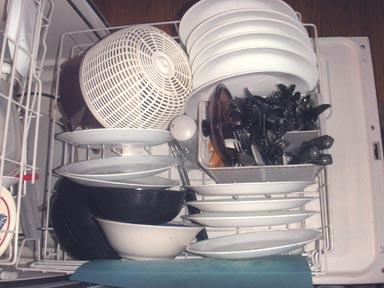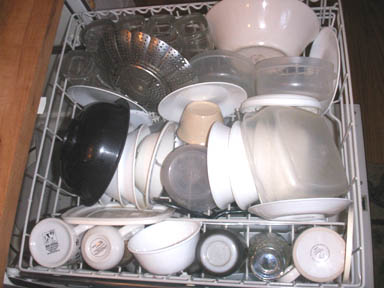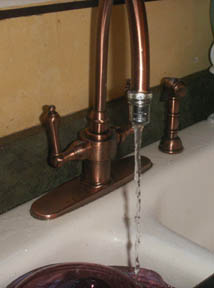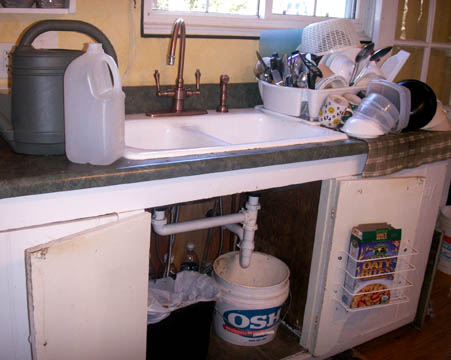Dishwashers vs hand washing is one of those debates that rages though the green community and you can find plenty of facts, research and evidence to support both sides.
Trouble is, that most people try to compare apples and (some un-specified fruit that proves the desired outcome) so we here at greenknowe.org set out to do our own first hand practical kitchen analysis.

 We started off by loading our dishwasher completely full as is we were going to run it. We made no special effort to rinse the dishes, just stacked them in. We are in the habit of maxing out our dishwasher and here is what that looks like. It took about 3 days with 3 people or about 9 meals.
We started off by loading our dishwasher completely full as is we were going to run it. We made no special effort to rinse the dishes, just stacked them in. We are in the habit of maxing out our dishwasher and here is what that looks like. It took about 3 days with 3 people or about 9 meals.
For the dishwasher data we will be relying on the manufactures data for water consumption and our Kill-a-watt for electrical consumption. Running the dishwasher on the "normal" setting without the heated dry or acu-temp settings uses 0.63 kwh and 7.8 gallons of water. Using acu-temp to heat the water raises the electrical consumption to 1.13 kwhs. We never use the heated dry. We simply open the dishwasher and allow the water to evaporate off the hot dishes.
 Instead of running the dishwasher this time we took all the dishes out and stack them beside the sink ready for hand washing. I developed my own method of hand washing while living in an apartment with room mates and no dishwasher.
Instead of running the dishwasher this time we took all the dishes out and stack them beside the sink ready for hand washing. I developed my own method of hand washing while living in an apartment with room mates and no dishwasher.
Now to detail the method of hand washing. This is important because it greatly influences the amount of water consumed so much so that hand washing is alternately said to use more or less water than a dishwasher.
1. First I run off the cold water into two 1 gallon jugs. I dont have two jugs right now so I run part of the water into a watering can as a temporary measure. I kept two 1 gallon jugs on hand when I was routinely hand washing dishes.
2. Drop the pots and pans into the bottom of the stoppered sink. No filling the sink, that would use more water.
 3. Turn on the hot water 1/4-1/3. Expecting the water to do the mechanical work of scouring the pans is silly. Turn down the water and get out the elbow grease.
3. Turn on the hot water 1/4-1/3. Expecting the water to do the mechanical work of scouring the pans is silly. Turn down the water and get out the elbow grease.
4. Apply a dot of soap to my scouring pad and go to work. The soapy water slowly begins to fill the sink as I wash the easy dishes giving the dirtiest dishes time to soak in the sink doubling up on uses for the water. I use the cold water from the jugs for rinsing. By the time sink is full of warm soapy water, Im almost done with the dishes. The two gallons of cold water I set aside has been enough to rinse most of the dishes.
In the end washing 3 days/1 dishwashers worth of dishes took me 0 kwh, 5.5 gallons of water, 45 minutes and about half as much detergent.
 Clearly using this method, hand washing is better if you can do modest size loads so that you have enough dishes to make heating up the water worth while and take full advantage of the cold water run off at the beginning. Doing dishes in small batches is going to be slightly less effective. I would say the quantity that was used for this experiment was larger than the optimal quantity for hand washing. I ran out of sink space, rinse water and space in the dish drainer.
Clearly using this method, hand washing is better if you can do modest size loads so that you have enough dishes to make heating up the water worth while and take full advantage of the cold water run off at the beginning. Doing dishes in small batches is going to be slightly less effective. I would say the quantity that was used for this experiment was larger than the optimal quantity for hand washing. I ran out of sink space, rinse water and space in the dish drainer.
There are of course still legitimate reasons for using a dish washer. Not everyone has the health to stand at the sink for half a hour. Some people with limited eco-hours would rather spend the time pursuing things that give an even greater benefit like biking to work or tending a garden. If you are a dedicated hand washer, you might consider making you life a little easier and more efficient by installing a pedal valve. A pedal valve will allow you to turn the water on and off with your foot without having to reset the temperature every time or dip soap all over the faucet.
If you are buying a dishwasher. . . Consider a second hand dish washer. You can use a little extra water for a long time before you offset the resource cost of an entirely new dishwasher. If you do go new you might consider looking for one that uses less than 5.5 gallons of water per load and as little electricity as possible. Also, Im under the strong opinion that portable dish washers are better and built in dish washers for three reasons. 1- You can run off the cold water before you connect the dish washer and set it aside for another purpose like watering potted plants. 2- You can put pots, pans and extra dishes in the sink to be rinsed by the hot soapy discharged. This allows you to double use your water. 3- They are mobile which means they can be borrowed, lent and transferred as needed.
- Log in to post comments